From old master’s paintings, antiques and design objects to contemporary art: the im Kinsky summer auction is offering highlights for every taste.
im Kinsky summer auction
Old Master Paintings
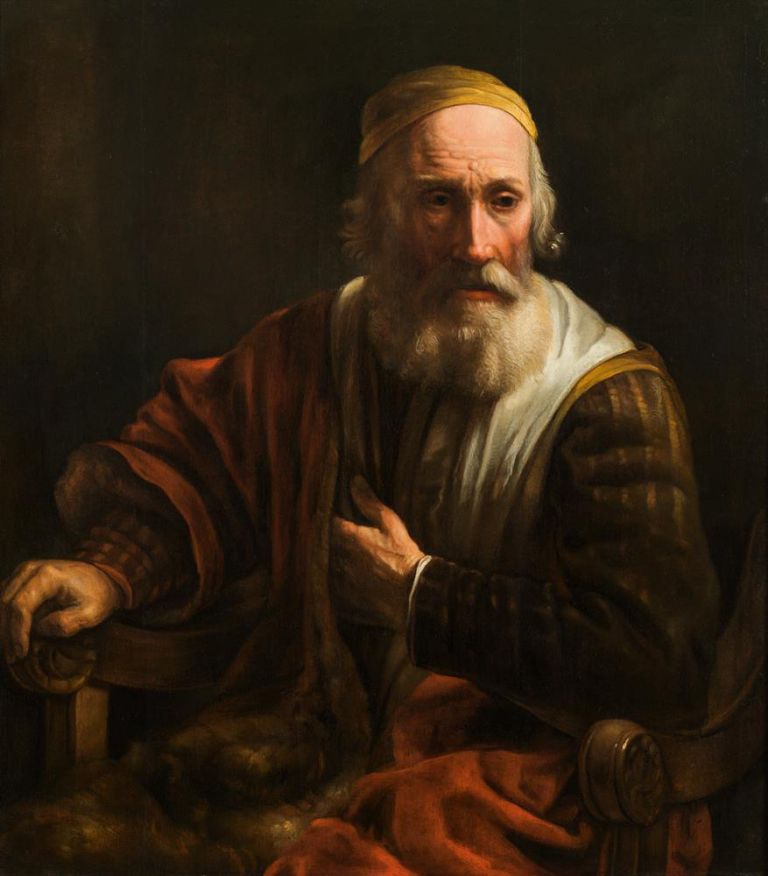
Porträt eines Philosophen, 17. Jhd.
estimate 60.000 – 100.000 €
Rembrandt used his profound portraits initially just as studies, but they have become one of his most recognizable assets, and an influence to his pupils.
This painting shows an old savant in his chair. The light from the upper right hand side draws the attention to his wrinkled face, his white beard and aged hands. The depiction of the clothing also is testament to Rembrandts typical way of painting. Warm colors are set in front of a dark background, while a brilliant red dominates the cape. The yellow stripes of the sleeves respond to the bright yellow cap. Through his admirable direction of light, the artist manages a very effective dramatization of the scene and a psychologically sound interpretation of fugacity and eternity.

Der Canal Grande mit Rialtobrücke von Süden her gesehen
estimate 25.000 – 50.000 €
im Kinsky summer auction
Already in the 18th century, the Rialto bridge counted amongst Venice’s most famous sights. Antonio Canal, named Canaletto, painted many views of the Canale Grande from the south and is therefore known as the composer of this special prototype. It was published by Antonio Visentini in his book of engravings of famous Venetian views in 1742. This composition shows many similarities to a signed and dated Canaletto work from 1744, and just differs in details from Visentini’s engraving and Canaletto’s oil painting.
Many versions of the theme were accomplished in Canaletto’s workshop, by his nephew Bernardo Bellotto (1722-1780), and by many other pupils and followers. This view used to be a much revered souvenir to bring back from a trip to Venice in the 18th century.
im Kinsky summer auction
19th Century Paintings

Andreas Hofer
estimate 100.000 – 150.000 €
im Kinsky summer auction
One of the most important influences on the young Albin Egger-Lienz was his teacher and fellow Tyrolian Franz von Defregger. He describes his first meeting with the revered artist in an essay for Defregger’s 80th birthday as having had a similar impression than a stout catholic would have finding himself in front of the pope. An amical relationship was soon established between the two artists, and the older commented and corrected the works of Egger-Lienz, 33 years his junior.
To get ahead but also to earn money, Egger-Lienz copied from 1888 many Flemish and Dutch Masters of the 17th century in the old Pinakothek in Munich. The high quality of these copies brought forward many commissions for the young painter, some by the intermediate of Defregger. Also, Defregger commissioned replicas of his own work and supported the younger artist financially. After finishing his studies in Munich, Egger turned to his homeland Eastern Tyrol, where he worked on studies for his large historic paintings as the “Ave after the combat on Bergisel” (1894-1897) und “The cross” (1898-1901). This dates his interest in the Tyrolian freedom movement to 1894, which is the year of this copy of Franz von Defregger’s “Andreas Hofer”. The work marks his concern with an important subject and documents at the same time his devotion to Defregger, which would last all his life.
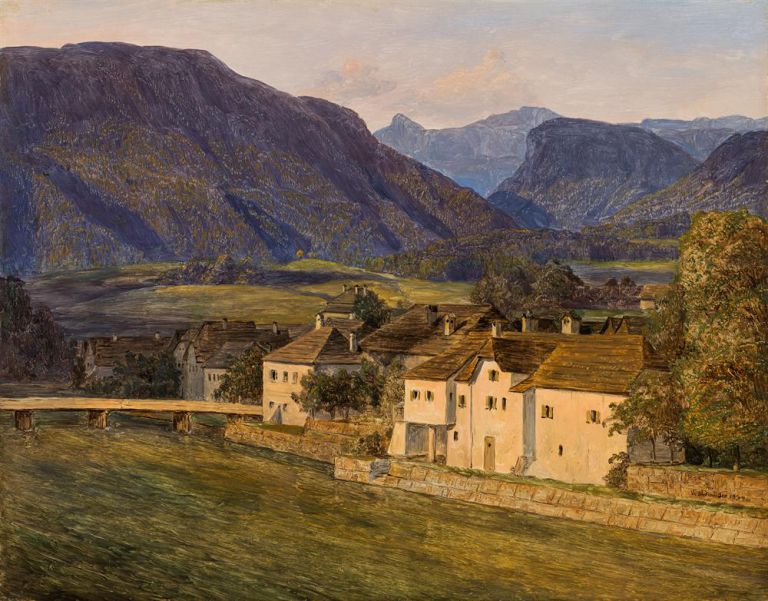
Das rechte Ufer der Traun in Bad Ischl, 1834
estimate 80.000 – 120.000 €
Nature is eternal truth; in her appearances, in her forms nothing is ever ordinary
Waldmüller
In the 1830-ies, Waldmüller discovered the landscape of the Salzkammergut. He toured this area, which was so rich in motives that he could masterfully render. At the beginning of August 1834 he left for a holiday in Ischl; his trip took him from Vöcklabruck and Ebensee to Ischl, from there to Hallstatt, to the Altausser lake, the Grundl lake and to the Loser mountain.
This work shows the right shore of the Traun river with the old wooden bridge in Ischl. Truthfully, the Loser mountain and the dead mountain range dominate the background. Being true to nature was Waldmüller’s first maxime. In a small format, he captures a pastoral scene with subtle color mastery. The house facades on the shore are lit by the sun and shimmer in ochre color, which juxtaposes them to the green shimmery water of the Traun river in the foreground and the blue-green glittering mountains in the background. This almost random scene offers a pure joy of viewing, while staying absolutely truthful – an early example of Waldmüller’s Oeuvre, where the direct touch of nature dominates.
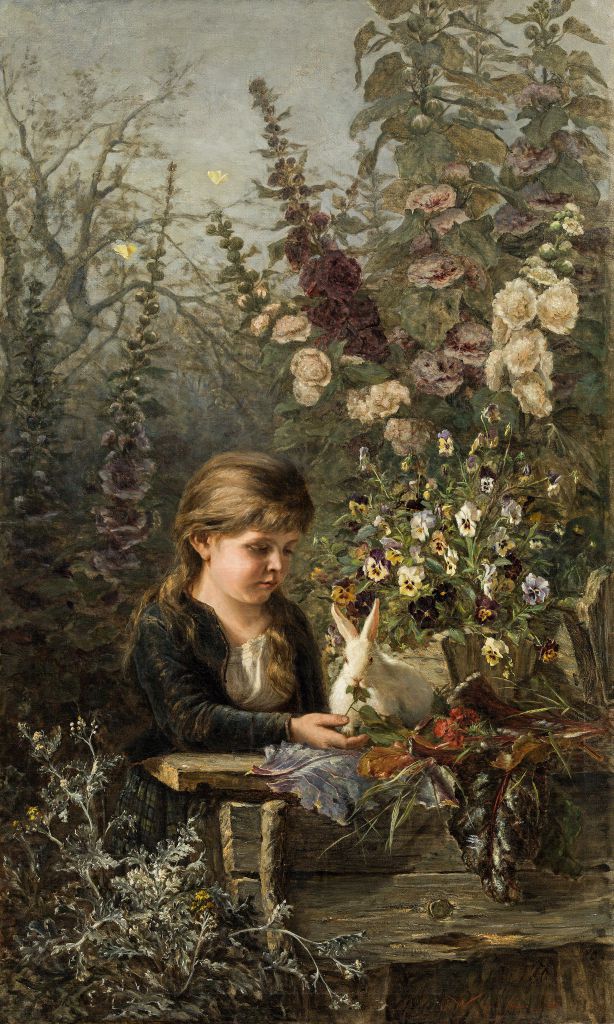
Mädchen mit weißem Hasen, 1883
estimate 35.000 – 70.000 €
im Kinsky summer auction
Olga Wisinger-Florian spent the summer months in Goisern, where she found many inspiring motives for her paintings in her garden. In her diary, she calls these pictures “bench pictures”, the main characteristics are a fusion of flower- and figurative painting. The work at auction shows a girl with her white rabbit, surrounded by lush flowers. In front of the child appears a small wooden bench on which it rests his underarm. The rabbit sits on the bench and is being fed with leaves that the girl offers with her right hand.

Mephisto
Öl auf Holz
estimate 10.000 – 20.000 €
im Kinsky summer auction
Grützner often based his work on literary themes from the opera and theatre. He was inspired by Shakespeare’s tragedies and Goethe’s “Faust”, too. He painted the persona of Mephisto frequently, as a part of larger scenes, but also on its own as mischievous figure in red clothing. During his lifetime, he received many awards and was called as Professor to the Munich Academy in 1886 which shows his standing among his contemporaries, in 1916 he was even ennobled. With Carl Spitzweg and Franz von Defregger, Grützner counts among the most important Munich Genrepainters of the late 19th century.
im Kinsky summer auction
Antiques

The auction house im Kinsky is offering a wonderful rare collection of objects from a cabinet of wonder, dating from the gothic period to the 19th century. The significance of these cabinets dates back to the Renaissanc. Here materials like ivory, ebony, agate, corals, silver, shell, crystal, bronze and coconut and amber have been used. The collection encompasses elaborate trophies from coconut, ivory and silver, memento-mori-objects, reliquary caskets, gothic Limoges objects, arms, guild signs and an overly sized globe. The diversity of the collection was supposed to mirror the diversity of the world.
From left to right
Calice with lid and hunting scene, german, 17th century
estimate: 15.000 – 25.000 €
–
Stone with coral, 17th century
estimate 10.000 – 20.000 €
–
Coconut calice, „“the wellbeing“, german, 17th century
estimate 15.000 – 30.000 €
–
Ivory Turning head, 17th century
estimate 6.000 – 12.000 €
–
Memento mori scull, 17th century
estimate 3.500 – 7.000 €
–
Memento mori scull, 17th century
estimate 5.000 – 10.000 €

Zwei Putti
estimate 20.000 – 30.000 €
im Kinsky summer auction
Giovanni Giuliani was born in 1664 as the son of a venetian baker. He studied probably in Venice and Bologna. From 1690 he lived in Vienna and since 1694 worked more and more frequently for the Heiligenkreuz monastery. He also worked for the princes Kaunitz and Liechtenstein, for whom he produced profane sculptures. 1711 he entered the monastery due to a private crisis and lived there for his remaining 33 years, continuing his sculptural work for the church.

19. Jh.
estimate 15.000 – 25.000 €
The figurine of Judith with the head of Holofernes has probably been shaped according to the example of Conrad Meist from 1525/1528 which is kept in the Bavarian National Museum. Judith saved the inhabitants of her hometown by killing the enemy commander Holofernes in his sleep. Contrary to the story, Meist and also our artist depicted Judith in the nude. However, this is not about an erotic representation, the bodily beauty of the woman is to be seen as a voucher for her moral integrity.
im Kinsky summer auction
Art Nouveau & Design
From left to right:
Ferdinand Preiss „Con Brio“
estimate 15.000 – 20.000 €
–
Valy Wieselthier Frauenkopf mit oranger Blume
estimate 9.000 – 15.000 €
im Kinsky summer auction
Classical Modernism

(Knabenakt in Wolken)
estimate 250.000 – 500.000 €
The nude youth is reclining in the clouds, far from any worldly concerns. The mountain scenery in the lower part of the picture supports the impression of the young men floating over the world. It is remarkable that the artist has chosen a title: “Feldeinsamkeit” (loneliness in the fields), which is recorded in the exhibition catalogue and a newspaper article from that time.
The painting was displayed at the beginning of 1916 in the Berlin Secession on the Kurfürstendamm in the “Viennese art show”. Franz Servaes lauded Koloman Moser’s paintings in his review “German art and decoration” and depicted the painting on a whole page of the journal, which is indicative for its importance among the exhibition.

Fernes Land, 1946
estimate 150.000 – 300.000 €
Men and animal communicate perfect harmony, thanks to their closeness and responding poses. This may not seem like a natural scene, but it does have much stage quality. It impresses through the use of exotic plants, fruits and creatures and through the harmonious depiction of the female nudes amongst the animals, conveying an almost paradisiac unity. In the background, almost as if seen through a window, there is danger tough for this idyll: Smoke is rising from a distant volcano.
Bresslern-Roth painted one version of this work in 1931, which is similar in many aspects.

“Encounter”
estimate 100.000 – 200.000 €
The persona of the farmer was central to Alfons Walde’s work, Kitzbühel being a peasant environment. He depicted the farmer within his natural habitat in many different versions. His interest was not drawn to the farmer’s work, but to their Sunday and holiday mood. In the setting “Encounter” which he came back to many times, three main characters are being shown in a small picture detail before or after going to church, on the snow covered village square. They do not show any individual traits. Walde renounced any sign of characterization, of physiognomy. His characters are not individuals but archetypes, playing out a universal situation. Few strong colors, powerful dark-light contrasts and stylized shapes show the very singular approach in color and shape of the Tyrolean painter.
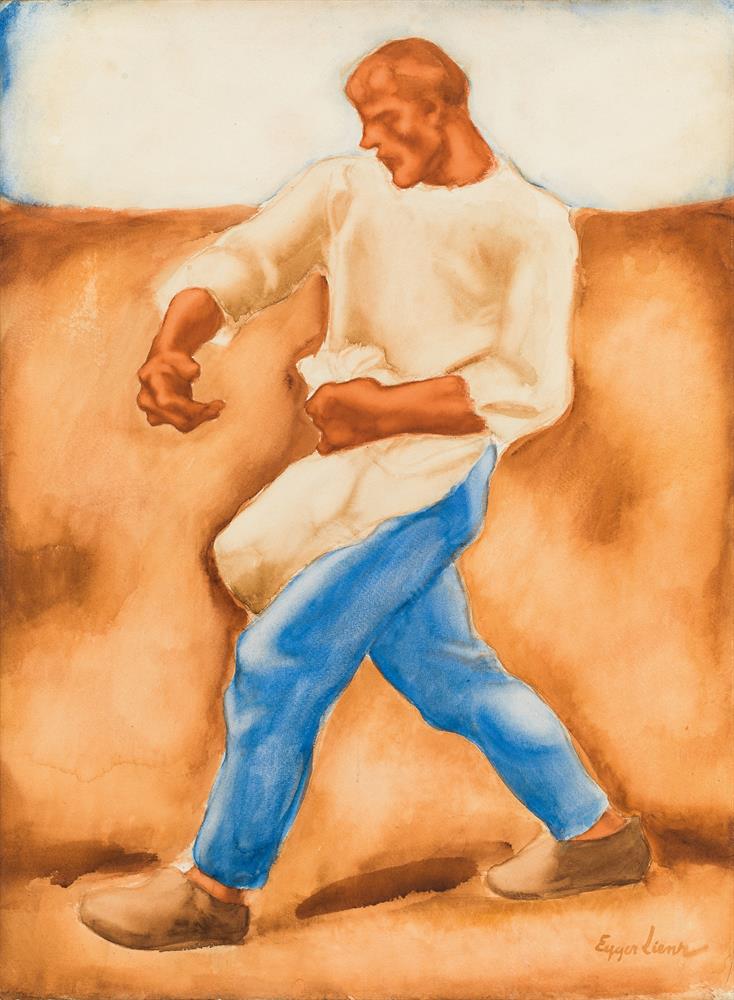
Sämann, um 1920
estimate 100.000 – 200.000 €
The artist has been working on the subject of the sower from 1903, in his middle phase he interpreted it with the “Sower and devil” in 1908. The present watercolor follows up on this work, a similar depiction from 1923 is kept in the Ferdinandeum in Inssbruck.
The monumental, graphic, typified character is occupying almost the entire height of the paper and shows a dynamic turn. The horizon is at shoulder-level, the sky on the edges corresponds with the stark blue of the sower’s pants. The earth reprises the red-brown color of the head and the hands. This “Sower” is an emblematic and very high-quality work from the Tyrolean artist’s late period.

Flamingos, 1935
estimate 100.000 – 200.000 €
Norbertine Bresslern-Roth(1891–1978) repeated similar motives in new variations in her paintings – among them the motive of bird migration. Another theme in this present work is exoticism, which is being represented and idealized by the choice of the color-intense and extravagant birds, the rich offer of southern fruits on the boats and their resting owners. It is notable that the point of view is not from the ground, but corresponds to the bird’s view. In 1937 Bresslern-Roth transferred this motive into her technique of linocut.
She also illustrated animal stories from Marie von Ebner-Eschenbach, Gerti Egg, adventure books of danish author Niels Meyn and fairy tales from Hans Christian Andersen, Oscar Wilde and the brothers Grimm. From the 1920-ies on, Bresslern-Roth designed school books and books on mathematics and natural sciences. Her love for the depiction of animals is always tangible.

Zwei Frauen auf dem Heimweg, 1962
estimate 80.000 – 150.000 €
“After my university studies and the dead circling of the Academies, I came later into the spell of the so called expressionism, which corresponds to the core of being “German” in a special way. But soon I had the feeling that an exalted sentiment leads to destruction, that any fashioning must stand under the law of shape and proportion.
In my painting I always wanted to combine a strict arrangement with the resonance of something alive and unique. Painting does not manifest itself through brush-brio and furioso or through the amount of the paint being used. My themes derive from my rural surroundings, but the shaping is the goal and not a gossipy anecdote. The figures of a Seurat are nearer to me than the sentiment of a Millet for example. I do not love when the background becomes foreground. Qu‘est-ce qu‘il y a de plus mystérieux que la clarté“, (what could be more mysterious than clarity) this word from Paul Valéry has been my motto through all my adult life.
(Werner Berg speaking at the opening of his exhibition in Paris, 19)

Brustbild einer Frau im Profil nach links, um 1904/05
estimate 75.000 – 150.000 €
This very subtle depiction is a well-known example of a series of female profiles that Klimt drew in 1904-05 using different models. These aesthetically pleasing sheets do not have any resemblance to his known painted portraits and were an end in themselves.
The female models, all wearing different clothes, are unified through the sharpness of their contours. The eye on view is half closed or closed, at the center of these works stands an expression of meditation. The introvert faces have been influenced by the idealized female portrays of the Dutch symbolist Jan Toorop, who Klimt revered from the 1890-ies on. Another source of inspiration was the art of portraits in the Italian Quattrocentro.
The metallic precision with which Klimt held his pencil in the 904-05 – a parallel to his early “golden paintings”– is especially evident in this drawing. This is heightened by the artist’s special interest in decorative structures like the small circles in the dress and the jewelry. Klimt’s differentiated drawing style is obvious in the poignancy of the face, the free flowing lines of the hair and the dress in the lower part, the only color accent being the subtle red of the closed lips.
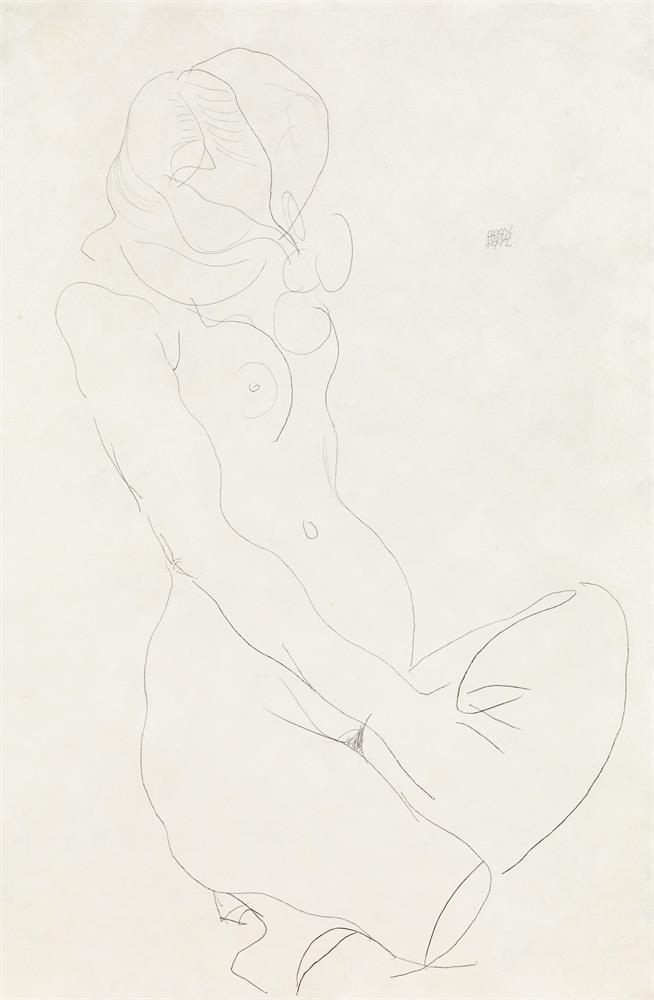
Weiblicher Akt, 1912
estimate 70.000 – 140.000 €
As shown on the back of the sheet, the Austrian sculptor Josef Riedl (1884-196) received this Schiele drawing from Ida Roessler, wife of the well-known critic Arthur Roessler. Schiele’s drawing stayed over many decades in the possession of the Riedl family.
In 1912 there was a notable change in Schiele’s drawing style. He used a harder pencil, his trait became looser and lighter, more delicate lines appeared. His hand led the pencil quickly over the sheet and captured the contours of the female nude with great certainty. The face of the nude is covered by her hair, as if she turned the head to the side and looked over her left shoulder, while Schiele’s quick pencil is capturing the moment of movement. The turned stance of the woman with her crossed legs and the outstretched right arm which shows her vulva is characteristic for Schiele’s interest in difficult body postures and unlikely points of view.

Junge Frau in rotem Kleid auf rotem Sofa, 1915
estimate50.000 – 80.000 €
Faistauer’s wife Ida has melancholically rested her chin on her left arm, dreaming and withdrawn, she is shown in a slight profile view from the right. They were married in 1913, and unto her early death in 1919 the artist painted her sixty times. The portrait is a very sensitive characterization of the model and shows at the same time the masterful use of color in his early portraits.
Next to Egon Schiele, Faistauer was one of the leading lights of the “Neukunstgruppe” – the new art group from 1909, which regrouped young artists wanting to protest against the conservative academic art market. Important impulses for Faistauer came from Paul Cezanne. They center on the nature-inherent structure and the painterly order which supposedly corresponds to the natural order. His portraits reflect the idea of the eternal objective value of shapes, as shown by the body and face of the woman being put into an oval or being delimited by curved lines, while color as sign of emotion lightens the strictness of the composition.

Föhn, 1927
estimate 35.000 – 70.000 €
With his masterly strokes, Rudolf Wacker has captured the array of colors and the special atmosphere of the lakes with tis fisherman’s huts and boats in this work from 1927. The Bodensee with its shore landscapes changing with the seasons is a motive that he repeatedly used in many oil studies and paintings. It draws light on the very special importance that the well-known landscape of his home held in Wacker’s Oeuvre and life. Painting in the open air offered the artist the opportunity to get away from his closed studio, and to forget for moments the experiences of his long captivity after the war, and to flee from the sorrows and angst of every day’s life.
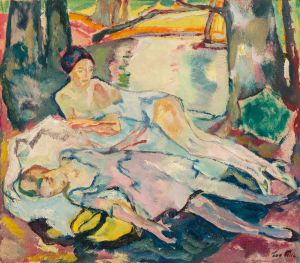
Siesta am Waldsee, 1925
estimate 25.000 – 50.000 €
im Kinsky summer auction
Contemporary Art

Les Fenêtres d’un Fluidoïd, 1957
estimate 150.000 – 250.000 €
Very much in the thinking of the Avant-garde, it is the union of life and art, of ecology and sustainability that percolate the work of Friedensreich Hundertwasser. In the area of architecture, he advocated a “human” way of building. It is only now that we are discovering how very visionary his ecological ideas were.
The foundation of his abstract picture compositions was always the debate with nature. He translated his perceptions into lines, spirals, drops and circles. He refused the straight line. It was the spiral that became a central part of his art, almost ichnographically so. It symbolized for Hundertwasser the eternal circle of life, growth and decay. “The spiral is the symbol of life and death.
The spiral is exactly where dead tissue is changed into life”, the artist wrote in 1983 in the book “Beautiful paths. Thoughts about art and life.”.
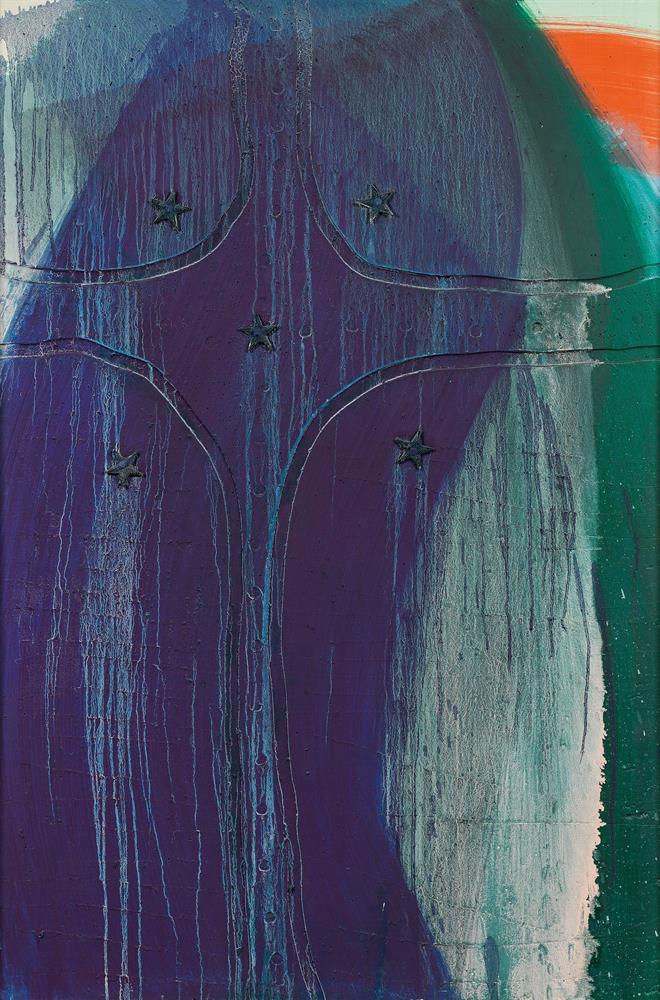
Schleierkreuz, 1998
estimate 75.000 – 130.000 €
Arnulf Rainer’s pictorial language is always changing, but always stayig true to the foundation of his art: gesture and color. The hand and foot paintings of the 1980-ies are precursors and at the same time counterparts, in their pastose colorfulness and aggressive gestures, of the veiled paintings of the 1990-ies. It is a series of works in which aggression and pastosity yield to a fragility and delicateness, without losing any intensity.
This work is from a series which adds an artificial element. Rainer covers the paintings support – the wooden board – mechanically with cuts, applications, grit and panels. There is the impression of a microstructure or scientifical structure.
The veiled cross paintings convey an unusual poetry, a particular wisdom and acceptance. The harmony of gesture and color with the paintings support leads to an engaging aesthetic appearance.
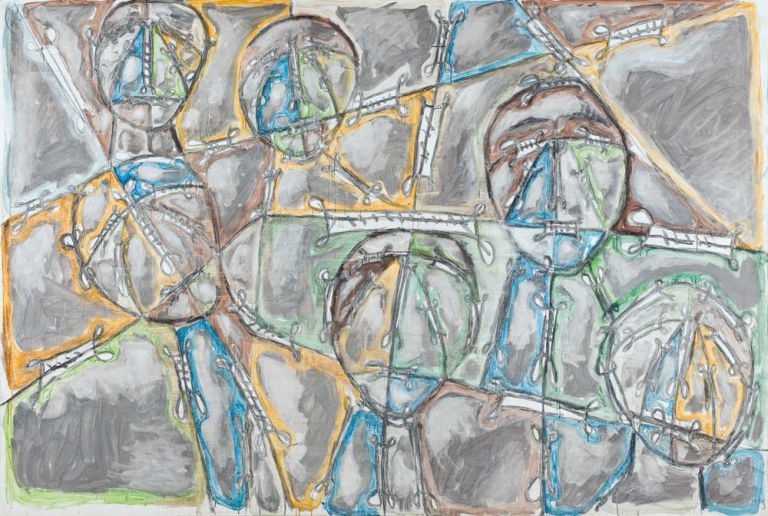
“Men without women”, Parsifal, 1993
estimate 80.000 – 120.000 €
Six heads in muted colors crowd the overly large, ridged canvas. There are no recognizable facial features, just a schematic and frontal representation of heads, whose expression appears merely sad. This work stems from one of the best known series of the artist: “Men without women – Parsifal”. From 1993-1997 Markus Lüpertz concentrated on this theme alone, which is inspired by the hero Parsifal from Richard Wagner’s last opera. It is dedicated to the theme of redemption from eternal temptation and the male dominated world.
Markus Lüpertz, born in 1941, counts amongst the best known German contemporary artists. As a representative of neo-expressionism, he works with the repetition of motives and the challenging of the viewpoint between abstraction and concreteness. The series „Men without women“ – Parsifal“ from which this work stems dares the viewer with its secretive content and opens different aspects of contemplating and interpreting it.

Weißes Kreuz auf schwarzem Grund,
1979er Jahre
estimate 50.000 – 100.000 €
Hans Bischoffshausen‘s return to Austria at the beginning of the 1970-ies from Paris marks a break in his biography and his art. After a decade of strict monochrome work, he allowed himself up to two colors per work which were used to define different zones. Next to other formal changes, he concerned himself around 1975 intensively with the cross shape. Bischoffshausen explained the decision to use this symbolic shape with wanting to get away from the rectangle of the canvas. He therefore denied any iconographic, historic or religious significance of the cross. The cross-series were (next to the “Horizon-series”) the last series on a large scale. Later, in the 1980-ies, the artist who was almost blind by that time worked only on paper and in smaller formats.

Friendly Corona, 2018-2019
estimate 35.000 – 55.000 €
The distinctive, life affirming works of this Arnulf Rainer pupil are difficult to put into an art-historic context. With their unique, very positive decorative shapes, they stand alone. The lust of colors, the richness of shapes and movements are always present in Dalpra’s sculptures: these are assumingly naïve creatures in intensive or even shrill colors. His mixed creatures make one think of aliens and micro-organisms: in this bronze, there is an unforeseen context within the Corona pandemic, which could be interpreted as cynicism on eh artists part, were it not for the much earlier creation date.
Dalpra’s work is not easily contextualized, but should bring happiness with its lightness, should nudge the phantasy of the viewer and offer large room for individual interpretation. Inspirations form far away countries and ethnics characterize Dalpar’as sculptures as well as their extremely haptic charisma. In the true sense of the word, one would like to “grasp” them.

Bali Queen, 2011
estimate 18.000 – 35.000
The contours of a figure barely emerge from this gestural, clearly abstract mélange of colored stains, strong lines and more delicate brush strokes. These vague intimations at the object in the picture correspond with the aims of Martha Jungwirth. Her goal is not a recognition of the picture’s motive, but its translation into colors, lines and surfaces.
Martha Jungwirths paintings oscillate between gestural abstraction and the concrete, her departure point is always somewhere in the perceived reality. The painting process is a reaction onto things seen and felt, and the emotions are linked to the function of the body.
im Kinsky summer auction




iThere are no comments
Add yours